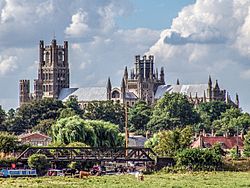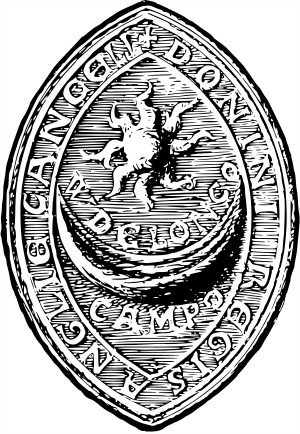William de Longchamp facts for kids
Quick facts for kids William de Longchamp |
|
|---|---|
| Bishop of Ely | |

Ely Cathedral
|
|
| Appointed | 15 September 1189 |
| Enthroned | 6 January 1190 |
| Reign ended | January 1197 |
| Predecessor | Geoffrey Ridel |
| Successor | Eustace |
| Orders | |
| Consecration | 31 December 1189 |
| Personal details | |
| Died | January 1197 Poitiers |
| Buried | abbey of Le Pin |
| Denomination | Roman Catholic |
William de Longchamp (died 1197) was an important leader in medieval England. He served as the King's Lord Chancellor, the top legal officer, and as Chief Justiciar, a powerful royal representative. He was also the Bishop of Ely, a high-ranking church official.
William came from a humble family in Normandy, France. He rose to power because King Richard I trusted him. When Richard became king in 1189, William bought the job of Chancellor. Soon after, he became the Bishop of Ely and was made a papal legate by the Pope. This meant he represented the Pope in England.
William governed England while King Richard was away on the Third Crusade. However, Richard's brother, John, challenged William's power. John eventually forced William to leave England. William also had trouble getting along with other important English nobles.
After William left, Richard was captured on his way back from the crusade. William traveled to Germany to help free the king. When Richard returned to England, William got his Chancellor job back. But he didn't have as much power as before. William was not always popular, but he kept Richard's trust until he died in 1197. He even wrote a book about law that was famous for many years.
| Top - 0-9 A B C D E F G H I J K L M N O P Q R S T U V W X Y Z |
William's Early Life and Family Background
William de Longchamp's family came from a village called Longchamps in Normandy, France. We don't know exactly where he was born, but it was likely near Argenton. His father, Hugh de Longchamp, owned land in England, just like many other Norman nobles after the Norman Conquest in 1066.
Some people who didn't like William said his father was a peasant. But this is probably not true. Hugh de Longchamp owned land as a knight, which meant he was part of the lower nobility. The family was not rich or famous at first. They became more important by serving King Henry II. William's father also owned land in Herefordshire, England.
William had several brothers and sisters. His sister Richeut married the castellan (castle commander) of Dover Castle. His brothers, Osbert and Henry, became sheriffs. Another brother, Robert, became a monk and later an abbot (head of a monastery).
William started his career working for King Henry II's son, Geoffrey. But he soon moved to work for Henry's other son, Richard. Richard was the Duke of Aquitaine at the time. He made William his chancellor for Aquitaine. William first showed his skills in 1189. He was Richard's representative in a disagreement with William Marshal, King Henry's representative. By then, William was already one of Richard's trusted advisors.
Becoming Chancellor and Chief Justiciar
When Richard became King of England in 1189, William de Longchamp was made Chancellor of England. He paid a large sum of money, 3,000 pounds, for this important job. After he became Chancellor, the cost of getting official documents sealed with the Great Seal of the Realm went up. This seal was needed to make documents official.
On September 15, 1189, King Richard also made William the Bishop of Ely. William was officially made a bishop on December 31, 1189. He took his place as Bishop of Ely on January 6, 1190.
Before King Richard left England in 1189, he put William in charge of the Tower of London. Richard also appointed William and Hugh de Puiset, the Bishop of Durham, as joint Chief Justiciars. The Justiciar was a very powerful person. They acted with the king's authority when the king was out of the country.
William and Hugh de Puiset did not get along. So, in March 1190, King Richard divided their power. Hugh was in charge of the area north of the River Humber, and William was in charge of the area south of it. By June, William had managed to remove Hugh from his position. William also received a special role from the Pope. He became a papal legate, which gave him even more authority in church matters.
As Justiciar, William sent judges all over the country to hear legal cases. He also gave the people of London the right to choose their own sheriffs. When William visited his diocese, he traveled with many servants and animals. People noticed how grand and expensive his travels were. He also worked to restore order in York after a terrible event where many Jewish people were killed in 1190.
Challenges and Disputes with John
William de Longchamp was from Normandy, and this caused problems. He sometimes didn't understand English customs. One writer, William of Newburgh, said William was "an unknown foreigner." It seems William didn't even speak English, which made it harder for him to connect with people. Important nobles complained that William ignored other officials King Richard had appointed. They also said he brought too many foreigners into important jobs. While the first complaint wasn't entirely true, William did put non-English people in judicial roles and as sheriffs. He also tried to take control of several English castles.
Throughout 1190, William had a difficult relationship with King Richard's younger brother, John. This led to William attacking Lincoln Castle. The castle's commander, Gerard de Camville, refused to give up the castle to William's chosen replacement. Gerard had sworn loyalty to John. In response, John took two other castles, Tickhill and Northampton.
King Richard heard about the conflict. He sent Walter de Coutances, the Archbishop of Rouen, to England in 1191. Walter helped John and William reach an agreement. Gerard remained in charge of Lincoln Castle, and John gave up the castles he had taken. William also agreed to help ensure John would become king if Richard died.
William's special role as papal legate ended in 1191 when Pope Clement III died. This took away some of his power. However, the new Pope, Celestine III, renewed his legation a few months later.
Another problem for William happened in September 1191. King Henry II's son, Geoffrey, who was Archbishop of York, was arrested by William's men. They were led by William's brother-in-law, the commander of Dover Castle. Geoffrey had been warned and sought safety in a church. But William's men attacked the church and dragged Geoffrey out. This violent act reminded people of the famous martyr Thomas Becket. Public opinion turned against William. William claimed Geoffrey hadn't sworn loyalty to Richard, but it was likely an excuse to remove a rival.
John's supporters started a strong campaign against William. One of the leaders was Hugh Nonant, the Bishop of Coventry. He and other powerful nobles held a meeting on October 5, 1191. William did not attend. The meeting decided to remove William from his positions and excommunicate him (kick him out of the church). After trying to hold the Tower of London, William had to give up because he didn't have enough support. The main reason for his downfall was his bossy behavior.
William went to Dover to find a ship to leave England. During his escape, he tried to disguise himself in different ways, including a monk's robe and women's clothes. He couldn't speak English, which made it hard to blend in. William finally managed to leave England on October 29.
Life in Exile and Return to Power
After leaving England, William de Longchamp went to the court of Henry VI, Holy Roman Emperor. The Emperor was holding King Richard captive at Trifels. William worked to arrange King Richard's release. He helped negotiate a ransom payment of 100,000 marks. The Emperor agreed to free Richard once 70,000 marks were paid and hostages were given for the rest.
In January 1194, the Emperor held a meeting to discuss King Philip II of France's offer to pay to keep Richard captive. William attended this meeting, along with Richard's mother, Eleanor of Aquitaine. After more talks, King Richard was finally freed on February 4, 1194.
When Richard returned to England, he rewarded William. He gave William control of the town of Eye and made him Sheriff of Essex and Sheriff of Hertfordshire. However, William soon got into another argument with Archbishop Geoffrey of York. King Richard left England again in May 1194, and William went with him. He never returned to England after that.
Richard continued to use William for diplomatic missions. He also kept William as his Chancellor. But the most powerful person in England now was Hubert Walter. William spent the rest of his life outside his diocese, usually traveling with the king.
Death and Lasting Impact
William de Longchamp died in January 1197 in Poitiers, France. He was on a diplomatic mission for King Richard to Rome. He was buried at the abbey of Le Pin.
Much of what we know about William comes from people who didn't like him. For example, Gerald of Wales called William a "monster with many heads." The historian Austin Lane Poole said Gerald described William as more like an ape than a man.
However, William was also known as a cultured and well-educated person. Some of his friends and supporters included Pope Clement III. When the Pope made William a legate, he said he did so because English bishops asked him to. When William became a bishop in 1189, a writer named Richard of Devizes said he was a man of "no little virtue and fame." Historian John Gillingham wrote that William's "record of his life in politics and administration was a good one, spoiled only by his failure in 1191."
Some historians see the meeting that tried William in 1191 as an early example of nobles coming together to challenge the government. This was similar to the meeting at Runnymede in 1215 that created the Magna Carta.
William also helped his brothers get important jobs. Henry and Osbert became sheriffs in the 1190s. His brother Robert became a prior (a church official) and later an abbot.
A medieval poet named Nigel Wireker dedicated a funny poem to William. Another writer and judge, Richard Barre, dedicated his legal work to William. William was one of Barre's supporters and helped him get jobs in the church and as a judge.
William de Longchamp likely changed how official documents were written. Before him, documents written in the king's name used "I." William probably introduced the "royal we" or "majestic plural," where the king's documents used "we." He also wrote a law book called Practica legum et decretorum. This book was a guide on how to use both civil law and church law in the French lands controlled by the Angevin kings. It was very popular in the Middle Ages and helped people involved in legal cases.
|



